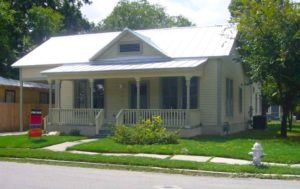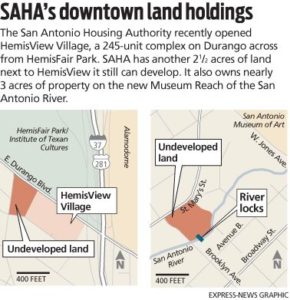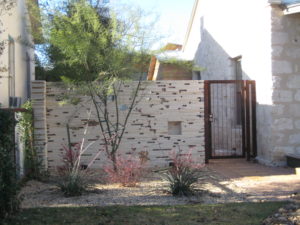My buyers just purchased and moved into this recently renovated home in Lavaca.
Express-News spotlights King William Realty
I was recently featured in the Sunday Express-News Real Estate cover article. Several of our listing were also highlighted.
Downtown Houses. Charm, space in urban homes
By Ana Ley
aley@express-news.net
Sunday, December 19, 2010
People seeking the excitement of an urban pad often have to compromise on living space. But there are plenty of places to find single-family homes just south of downtown.
This area is ideal for people who seek a social environment and a central location. Houses there are generally older and have interesting architectural details, and they usually are close to restaurants and the art scene. They’re also roomier than the apartments and condominiums traditionally associated with downtown.
“There’s always something to do, and everything is so close and walkable,” said Curtis Bowers with King William Realty, who has lived in the Lavaca Historic District for the past four years. “It’s unlike anywhere else in San Antonio.”
The King William Historic District offers homes from around the $200,000s to multimillion-dollar mansions. The 25-block area on the south bank of the San Antonio River was the most elegant residential area in the city in the late 1800s, according to the King William Association. Prominent German merchants originally settled the area, which was zoned as the state’s first historic district.King William also has two districts recognized by the National Register of Historic Places, as well as individual properties that are recognized for their historical significance.
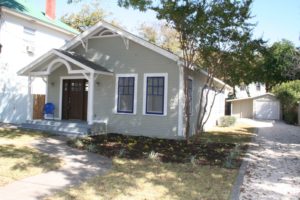
The 526 Mission Street home, located in the King William Historic District near the Eagleland segment of the River Walk and the Blue Star Arts Complex, has been remodeled and features a single gar garage with two off-street parking spaces. the home's French doors open onto a large deck and yard. Listing price is $229,000.
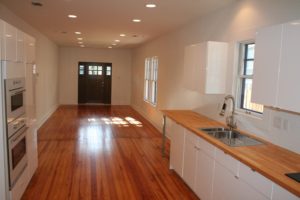
This contemporary renovation at 526 Mission St. in King William has two bedrooms and two bathrooms. Built in 1940, it has plenty of natural light and Ikea kitchen appliances.
The Germans who moved to San Antonio began building mansions with various architectural styles, such as Greek Revival, Victorian and Italianate. Ernst Altgelt, the first to build on current-day King William Street, is believed to have named the street after King Wilhelm I of Prussia.
In the 1920s, many of the mansions were turned into apartments, and young professionals eventually rediscovered King William and began a renaissance that continues to this day. The district was expanded in 1984 to include a neighborhood of cottages south of Alamo Street.
“The biggest attraction is the historical homes,” said Zet Bear with the King William Association.
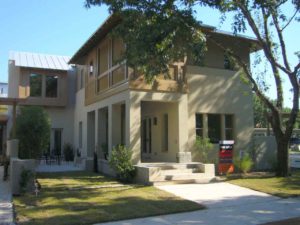
The garden home, at 414 Madison St., has an open-entry gallery with a large side courtyard. The three-bedroom, three-bath house has a large screened balcony off its master bedroom. The home also has high ceilings and polished concrete floors. It has a listing price of $659,000.

This garden home is at 414 Madison St. It has an open-entry gallery with a large side courtyard. The three-bedroom, three-bath house also has a screened balcony.

The Madison Street garden home has high ceilings and polished concrete floors. It has a listing price of $659,000.
Lavaca, just east of King William, is a more affordable alternative. Homes there currently are priced from the $70,000s to about $500,000.
The area is a hub for local artists, and residents say its diversity makes it one of the most vibrant places in San Antonio. Many older houses there have been remodeled by homeowners, creating a collage of individual tastes and colors.
Bowers’ Lavaca home is a yellow Victorian that he and his wife decorated with modern art created by artists from the area.
“We have a friend who’s an art dealer,” Bowers said. “We’ll walk around at night and always run into friends.”
Lavaca’s residential sector is also among the oldest in the San Antonio area that has survived into modern times. The neighborhood is surrounded on the north by East Durango Boulevard, on the south by the Union Pacific railroad tracks, on the east by U.S. 281, and on the west by South St. Mary’s Street.
Architecture in the neighborhood is defined by small 19th-century vernacular houses built primarily by working-class families beginning in the early 1870s. Around this time, San Antonians were building bigger homes nearby in the King William neighborhood. Among the neighborhood’s original residents were carpenters, stonemasons, shopkeepers, clerks, tailors, bartenders, teamsters and butchers.
The houses are mostly one story with some two-story buildings scattered throughout the area. They range from very simple homes to highly decorated ones, from stone cottages to Victorian and Craftsman houses. There also are a few Neoclassical homes in the area.
King William and Lavaca are divided by a region commonly referred to as Southtown, the area’s commercial corridor, which is home to popular spots such as the Blue Star Contemporary Art Center, the Sterling Houston Theater and Mad Hatter’s Tea House & Café.“It has an eclectic lifestyle,” said René Guerrero, former president of the Southtown Chamber of Commerce and King William resident. “And you get to enjoy the quiet part of the River Walk.”
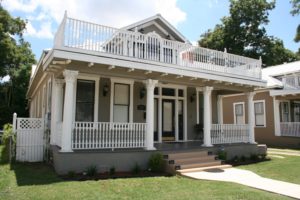
Built in 1920, this four-bedroom home is steps away from the River Walk and has an upstairs balcony with a view of downtown San Antonio. Historic features include a stone fireplace and a coffered ceiling. The house, at 206 E. Arsenal St., has off-street parking with room for a garage. The 2,409 square-foot home is priced at $415,000.
Mike McClain, a former suburbanite, said he enjoys downtown area living because of the area’s contemporary art community. The Dallas native is living at the Pearl Brewery complex while he and an architect design a new home in the downtown area.
“There’s just a lot of wonderful culture,” McClain said. “The thought of having short commutes to galleries and art shows is just so appealing.”
Austin-San Antonio commuter rail line update
My favorite quote of the article, “The unfunded plans…are akin to discussing which topping will go on a pizza when no one has money to order.”
Hopes for a Austin-San Antonio commuter rail line get boost. Funding still far off for high-speed line.
By Jacob Dirr
Austin Business Journal
November 26, 2010
The Texas Transportation Commission approved a comprehensive, statewide rail plan this month that includes the Lone Star Rail plan, aimed at linking San Antonio and Austin with commuter rail.
At the same time, an internal TxDOT study is indicating that a high-speed rail system from Houston would be cheaper if it connected to Austin instead of San Antonio.
The unfunded plans, while an important step forward, are akin to discussing which toppings will go on a pizza when no one has money to order.
“We don’t want to raise expectations yet, because there is no money,” Alamo Regional Mobility Authority Vice Chairman Robert Thompson said. “Let’s be patient. It’s not time to order yet.”
The Texas rail plan, known as the 2035 Statewide Long-Range Transportation Plan, was adopted on Nov. 18 after an aggressive effort to finish before state lawmakers convene in January.
The plan was also given a push from the federal government, which left Texas in the dark regarding more than $8 billion in funding awards because the state did not have a cohesive plan.
Lone Star’s aligning
For the Lone Star rail plan, which has been under serious planning for years, inclusion in the Texas rail plan satisfied one of four conditions the Federal Railroad Administration said must be accomplished if local planners want the administration to take the lead, said Bill Glavin, TxDOT’s rail chief.
Three of the four conditions have now been met. The final is approval from the Surface Transportation Board, a federal regulatory agency charged with resolving railroad rate and service disputes and reviewing proposed railroad mergers.
Glavin said the STB review is under way.
The rail plan will also be included in a multiyear Texas-Oklahoma high-speed rail study announced in October.
In September, TxDOT also allocated $8.7 million for the second phase of a preliminary engineering study needed for Lone Star Rail.
The Houston connection
Apart from the Lone Star rail plan, two proposals have been floating around on a high-speed rail network connecting the Dallas, Houston and San Antonio-Austin regions.
One proposal, known as the “T-bone” or “wishbone,” runs a line from Dallas through Austin, to San Antonio.
The other part of the “bone” connects Houston to Temple — north of Austin.
Another plan proposes a triangle connecting the three large metros.
Whether San Antonio or Austin would be the third point of such a triangle is unknown.
Thompson said a study, complete or nearly complete, indicates it will be cheaper to connect Houston to Austin because less right of way would have to be bought.
“Being from San Antonio, I was not fond of that idea,” Thompson said. “In a friendly kind of debate, we will have to decide that.”
Glavin said that while Austin would appear cheaper, it is assumed that a line from Houston to San Antonio would have greater ridership.
More riders equals more money, which could offset the greater cost of connecting to San Antonio.
Amtrak already provides service between San Antonio and Houston, and that line, owned by Union Pacific Corp., could also be converted.
If the triangle plan eventually emerges as the favored plan, either Austin or San Antonio would receive an economic boost from the connection.
That question will be studied over the next two to three years, Galvin says.
Univision selling major site for development downtown
Univision is seeking buyer for its River Walk property
By: Tracy Lynn Silva
San Antonio Business Journal
December 10, 2010
The search is on for a new owner for a piece of land along San Antonio’s renowned River Walk.
Univision Communications Inc. has hired the local office of New York real estate firm Jones Lang LaSalle (JLL) to market the sale of its downtown real estate property — a total of 4.34 acres of land at 411 East Durango.
The asking price was not disclosed. The property is currently valued at roughly $2 million, according to information from the Bexar Appraisal District.
For Univision, the sale would provide a financial vehicle for the media firm’s plans to consolidate its various divisions — including its television operations, which are currently located at the Durango site, and its radio and ad sales departments. The latter two are located in separate office buildings in North Central San Antonio.
For San Antonio, the sale could serve to spur some new development activity in the center city.
The land is zoned for mixed-use development, explains John Taylor, senior vice president of capital markets for JLL. Taylor and Elysia Ragusa, senior managing director of the commercial brokerage firm, are heading up the Univision assignment.
Taylor adds that the land would be ideal for a mix of retail, multifamily and office development, and even a structured parking lot.
Even the seller sees the potential for such a project.
“(The site) is very well located in the heart of San Antonio,” notes Luis Patino, vice president and general manager for Univision San Antonio. “It’s convenient to all of the venues downtown, and very accessible to the major expressways in San Antonio.”
It is simply more land than Univision needs, or wants, to own, explains JLL’s Taylor.
At present, the media company utilizes about one third of its Durango land — namely a two-story building measuring 21,000 square feet that houses all of the departments for KWEX-TV — the local Univision affiliate.
Meanwhile, Univision Radio has its offices at 1777 N.E. Loop 410. The Univision Spot Office, or ad sales office, is located at 70 N.E. Loop 410.
Univision leases roughly 20,000 square feet between the two properties.
The goal now is to bring all of Unvision’s functions under one roof, says Patino, who adds that the company is leaning toward leasing, rather than owning, such a space.
Univision, however, does not plan to vacate the Durango site right away, says Taylor. For a new owner, that means an opportunity for “immediate income as the final designs and permitting on the project are completed,” he adds.
As for where Univision will ultimately land, “They would like to be downtown, if they could find the right place,” Taylor continues.
Could that plan involve staying at Durango as a tenant in a mixed-use project?
“We will consider all scenarios that make operational and economic sense for Univision,” Patino says.
The property has already garnered interest from a mix of local, regional and national developers, Taylor says.
The investment side of the real estate market has not exactly been a hotbed of activity of late.
Still, the political climate of San Antonio makes it an opportune time for putting the Univision tract on the market, Taylor continues.
That climate, he adds, is one that has city leaders looking at ways to bring more life back into the center of the city.
“It is a phenomenal opportunity for mixed-use development,” says Ben Brewer, president of Downtown Alliance San Antonio, of the Univision land.
Prime location
At 4.34 acres, the Univision site is one of the larger tracts of land still available in the downtown area. Its size, Brewer continues, lends itself to a developer that can bring some new retail and residential to the central business district.
“Definitely, it ought to have a multifamily component,” says Brewer, who has been very vocal about the vital link between residential development and the center city’s revitalization.
High density is key to a successful development, continues Brewer, who adds that he and other stakeholders would like to see something in the “New Urbanism vernacular.” That would involve a project with a mix of uses, built around a pedestrian friendly environment.
Given the high visibility of the Univison land, such a project could also serve as a model for other developments in the New Urbanism vein. “This is an opportunity for a great model for that kind of development we’d like to see downtown,” Brewer says. “Get it in the right hands of a good developer, this could be one of those sites we tout as a great opportunity for downtown.”
Downtown Parcels Make SAHA Major Development Player
Housing agency one of downtown’s biggest developers
By Jennifer Hiller/jhiller@express-news.net
Published: Sunday, December 12, 2010
Photos: Bob Owen
Not too long ago, vacant downtown property owned by the San Antonio Housing Authority seemed unimpressive: a few acres along a weedy ditch and another site that was a blighted, notorious public housing project.
That was then.
Today, SAHA finds itself in command of some properties that private developers would envy.
The largest chunks of remaining vacant land it holds are about 3 acres of River Walk property in the rejuvenated Museum Reach section and 2 1/2 acres on Durango across from HemisFair Park, with a view of the Tower of the Americas. These are suddenly prime sites that the city desperately wants redeveloped.
But even with a shortage of downtown rental units, SAHA’s role in building more downtown housing — particularly market-rate rentals — is not without debate.
Its core mission is building and maintaining affordable housing, and it serves about 65,000 adults and children — with a waiting list of thousands more. So the agency walks a fine line as it tries to mix up the socioeconomics of its properties by adding market-rate units downtown that compete with private businesses during a tough economy.
“When they put units on the ground, it’s like any other project,” developer Steve Yndo said. “They compete with your project.”
The agency has no solid plans or a timeline for what it will do with its remaining vacant urban sites.
However, given the slow economy and ongoing difficulty in securing construction financing for private projects, SAHA finds itself among the few downtown players positioned to move forward.
“Business leaders have told us they want to attract more jobs and people downtown,” said Lourdes Castro Ramirez, president and CEO of SAHA. “We’re at a point where we know we all have a role to play.”
Last week, SAHA belatedly celebrated the summer opening of HemisView Village, a mixed-income apartment complex that’s part of the Victoria Commons development — where the crime-ridden Victoria Courts public housing used to stand.
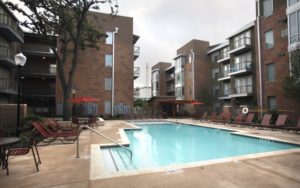
SAHA's HemisView Village is a mixed-income apartment complex that's part of the Victoria Commons development where the crime-ridden Victoria Courts public housing used to stand.
Of 245 apartments at HemisView, 12 are affordable units and 49 are public housing units.
The remaining 75 percent, or 184 units, are market rate, with rents between $741 and $1,264 and renters who don’t qualify for any sort of public subsidy.
Mayor Julián Castro wants the agency to keep building.
“As a public entity, SAHA in some ways is more nimble during a downturn,” Castro said. “SAHA’s primary mission is to create quality, affordable housing. While it’s doing that, it can serve as a powerful economic revitalization tool.”
Debating market rate
The biggest potential threat SAHA poses to private developers: It owns land outright, doesn’t pay taxes and receives government subsidies.
Meanwhile, developers struggle to get loans in the tight credit market.
Although high for San Antonio, downtown rents already border on the low side for developers to make a successful project, given the higher costs of working in urban areas. Many projects are on hold.
And thanks to changed mortgage-lending guidelines, some condo projects have switched to rentals, including one that Yndo helped develop, the St. Benedicts lofts.
With city and civic leaders pushing for thousands more downtown residents, developer David Adelman, partner at Cross & Co., said SAHA can help keep a diverse income mix downtown, which he believes makes for the best kind of neighborhood.
“We think the market is better served by more units,” he said. “I’m all for development if they can figure out how to get it going and done.”
But SAHA’s market-rate units make developers nervous.
SAHA’s approximate market-rate rent is a little more than $1 per square foot at HemisView, according to data compiled by Cross & Co.
Most other new, market-rate properties charge between about $1.30 and $1.50. The highest rents are at the Pearl Brewery, and average between $1.50 and $1.65.
“The problem is if they undercut rents,” Adelman said. “SAHA has to be careful not to use their advantage to suppress rents. It would establish the market at a rate below our ability to compete.”
On the other end of the spectrum, advocates for affordable housing don’t want to see SAHA sacrifice safe, work-force housing to add market-rate units.
Community activist and former City Councilwoman Patti Radle said she’s concerned that SAHA’s market-rate units are supplanting too many affordable apartments.
“It’s a real philosophical premise. Is San Antonio for everybody or is it for a certain sector?” Radle asked. “What happened with Victoria Courts did erase a lot of the affordable housing. (Downtown) is a very helpful location for people who are on low incomes. It makes the city more accessible.”
At the same time, Radle said she understands why SAHA wants to add some market-rate units to its projects.
“I don’t want to create poverty pockets,” she said. “I appreciate that and I think that’s important.”
Victoria Courts once had about 660 units. At the renamed Victoria Commons, where HemisView was built, another rental unit SAHA opened in 2004, Refugio Place, has 50 units of public housing, 55 of affordable housing and 105 at market rates.
Ramirez said SAHA never can meet the demand for housing, but wants residents to socialize across socioeconomic groups. Creating mixed-income communities avoids problems historically associated with isolated islands of public housing, she said.
Yndo said he doesn’t think SAHA has undercut the market so far, and the bigger issue for downtown redevelopment is attracting more high-quality jobs and small companies.
“The market is $1.30 to $1.35, which is hard to do anyway, but that’s San Antonio,” he said. “Unless we get quality jobs and people who are making $50,000 to $60,000 a year out of college or by their late 20s or early 30s, it’s going to be hard to build units.”
HemisView
Some say that even when SAHA does market-rate units, it’s not really in direct competition with private projects, which lately have offered amenities such as Pilates studios and sleek, industrial interior finishes with concrete floors, expansive windows and exposed ductwork.
HemisView does have amenities such as a pool, a secure parking garage and the like, but it’s not apples-to-apples with some of the luxury amenities at other communities.
“They don’t have all of the high-end amenities,” Yndo said.
Sandra Valadez moved into HemisView in July with her boyfriend after searching for rentals mostly in Alamo Heights.
At more than $1,200 a month, the rent was a stretch, but Valadez said they couldn’t resist the views. “We looked at each other and said, ‘This is out of our price range, but we’re going to do it.’ ”
Despite HemisView’s Tower views, Irby Hightower, principal at Alamo Architects, said SAHA probably won’t ever threaten other developers.
“They’re a public agency. It just doesn’t happen,” he said. “The hardest thing for SAHA to do is build real market-rate units with nice materials and expensive fixtures and so on.”
But SAHA can do projects that others can’t.
“No one else right now is really building,” Hightower said.
Because commercial financing depends heavily on what’s happening nearby and pioneering developments make lenders wary, SAHA’s downtown work could prove a viable market exists.
“A typical commercial developer can’t be first,” he said. “They’re not allowed to be first.”
River plans
SAHA’s river property occupies a prime position in River North, a light-industrial area the city wants to see turned into a mixed-use mecca with residential, retail and office space.
A master plan adopted last year looked at the 377-acre area along the refurbished 1 1/2-mile Museum Reach river segment as one of the best places to add more local people — not hotels — downtown.
Prior to the river face-lift, the gritty area largely was overlooked. SAHA in 1940 built the Rex Apartments at St. Mary’s and Brooklyn streets, backing up to the San Antonio River. Seniors lived in the 89-unit subsidized housing complex.

In the 1940s, SAHA built the Rex Apartments on the land that's now next to the locks and dam on the San Antonio River. When renovation proved too costly, the housing authority razed the complex in 1999.
In the late 1990s, SAHA tried to sell the aging property. Then it switched course and wanted to renovate, but that proved too costly, and the project was torn down in 1999.
Today, it has a direct view of the river’s new lock-and-dam system and is a short walk from the San Antonio Museum of Art and Municipal Auditorium.
Ramirez said the agency has “kicked around some ideas” about what to do there. “It’s prime property,” she said.
Ben Brewer, president of the Downtown Alliance, thinks the property could support between 200 and 300 housing units.
“They realize it’s one of the best locations on the river,” he said.
But Brewer is among those who would rather see SAHA sell the property for a fair price and use the proceeds to build on a different site.
Developer James Lifshutz, too, believes the property is simply too excellent.
“The site deserves a much higher-end residential product than SAHA has experience building,” Lifshutz said by e-mail. “Thus, in my opinion, they should sell that site and use the proceeds to further their mission elsewhere.”
Ramirez said SAHA hasn’t had any purchase offers in recent years, but emphasized that whatever it does with the land will happen with community involvement.
“We have no concrete plans,” Ramirez said. “We want to begin a very open, transparent process to determine what to do with that property.”
But before the river property, Ramirez said SAHA’s immediate goals include the construction of homes for first-time buyers at Victoria Commons and completing a plan to articulate what the agency wants in new developments.
It’s also using federal stimulus funds to renovate several aging facilities.
Then it will return to the river site.
“I think the Rex property is tied in with the whole River North area,” she said. “There are a lot of key players. We have to figure out what can be reasonably achieved in the next five years or the next 10 years.”
Potential plans
Immediately next to HemisView, SAHA has 21/2 vacant acres left to develop, which it has designated for commercial use.
The Lavaca Neighborhood Association wants a grocery store there, and that parcel will be considered during the master planning process for HemisFair, which recently started.
SAHA won’t necessarily have to follow the HemisFair plan, but Ramirez said the agency has met with the planners and wants to participate in the process.
It’s a different approach than the agency might have taken a few years ago.
Prior to the arrival of SAHA board Chairman Ramiro Cavazos and Ramirez, previous SAHA leaders had a turbulent relationship with residents and neighbors.
“I think the agency was more isolated,” Ramirez said. “We have a different approach now.”
That new attitude has left many optimistic, but cautious.
Yndo said he is in favor of good SAHA developments but that history shows that’s a struggle.
“The HemisView and Victoria Courts turned out real well, but it took the neighborhood and a lot of the architects who live in the neighborhood to hold their feet to the fire to make sure they did a quality job instead of a standard-issue suburban project,” Yndo said.
Seahn Lobb-Barrera, president emeritus of the Lavaca Neighborhood Association, said the success of HemisView — already 85 percent leased — and SAHA’s vastly improved community relationships have given him confidence in the agency’s ability to develop downtown.
“It’s like night and day, to put it quite frankly,” he said.
The new approach is this: “There is no ‘they,’” Lobb-Barrera said. “It’s ‘we.’ We’re their neighbors as much as they are our neighbors. It’s, ‘What do we want to do in our neighborhood?’”
Downtown plan is crucial, contends exiting Convention & Visitors Bureau boss
This is a great article recently written by W.Scott Bailey and posted in the San Antonio Business Journal on November 5, 2010. Scott White and others make the strong case that while San Antonio thrives on tourism we need to be deliberate in creating a more “authentic” feel with greater emphasis on local neighborhoods and local artists in places like Southtown.
Scott White, outgoing director of the San Antonio Convention & Visitors Bureau, says the Alamo City can boost its hospitality industry if local leaders can create a master plan for downtown that better connects and utilizes existing assets and which lures more residents.
White, who is leaving later this month to become president and CEO of the Palm Springs Desert Resorts Convention and Visitors Authority in California, says hospitality industry officials must also work with government officials to integrate tourism with economic development.
“These things are interconnected and I really think the tourism leaders understand that and support that,” White says.
Tourism is a multibillion-dollar industry in San Antonio. But the Alamo City faces increased competition as other markets continue to make investments in their infrastructure and changes to their game plans.
One of the things San Antonio needs if it hopes to continue to grow its hospitality industry, White maintains, is a “master plan for downtown.”
Ben Brewer, president of Downtown Alliance San Antonio, agrees. And he says that plan should call for a “substantial addition” of new residential units. He says that component is necessary for center city revitalization and sustainability and to further reinforce San Antonio as a world class destination.
“Great downtowns are lived in, and ours should be no exception,” he says.
White says San Antonio must address the migration of people and businesses to suburbia.
“It’s happened in a number of cities,” he explains. “The further out you go, the land becomes cheaper. Developers take advantage of that.”
White says its “vital” that San Antonio leaders work to reverse that trend, that they come up with a way to attract residents to the center city.
More authenticity
Robert Thrailkill, general manager of the Hilton Palacio del Rio hotel, says San Antonio does indeed need a cohesive plan for downtown so it can attract more residents and visitors to the city’s center.
“It’s a very important priority,” he says. “We’ve got to do this.”
Thrailkill says the residential component is important because it’s the livability factor which can attract more visitors to an urban area.
“It’s about creating more authenticity,” he says. “That’s what people are looking for in great cities.”
One way San Antonio can entice more of its people to move downtown is to encourage more of its larger employers to move their operations to the center city.
“My hope is that we get our act together and determine what it will take to bring some corporations downtown,” he says. “It’s critical.”
White says San Antonio can grow its hospitality industry by better leveraging some of its existing downtown assets. He points to the Southtown arts district and historic St. Paul Square as examples of urban areas more people, including cultural tourists, would want to explore if they were more visible and accessible.
“What a difference that could make,” White says.
San Antonio Mayor Julian Castro is optimistic that local leaders will find ways to breathe new life into this city’s historic downtown.
In fact, Castro has referred to this as the “decade of downtown,” while pushing for the redevelopment of HemisFair Park and for other infrastructure needed to grow the residential population in the center city.
Connecting the dots
White says Centro Partnership, a new nonprofit corporation tasked with creating public-private support for downtown improvements, could be instrumental in helping bring about necessary changes.
“You’ve just got to create the vehicle that can cut through the red tape,” he says. “Hopefully this (partnership) won’t get mired in politics.”
Hixon Properties Inc.’s Jack Spector, one of the “incorporators” who filed documents with the State of Texas in July establishing Centro Partnership, says San Antonio has lacked a “unified vision” for downtown. But Spector believes the new partnership can be an “agent for change.”
San Antonio has lured millions of visitors annually to its River Walk because of its unique appeal. Local leaders would like to create more foot traffic at the street level.
“San Antonio needs to figure out what it can do at the street level to complement (the River Walk),” White says.
He believes San Antonio should develop more creative spaces at the street level for artists and musicians.
“Visitors are attracted to places that are real and not contrived,” Brewer contends. “By growing the downtown neighborhood, real places that are frequented by locals from the center city and the suburbs will be established. That is where our visitors coming to San Antonio will choose to hang and dine and frequent.”
White believes the Alamo City has the leadership in place that is needed to create and carry out a comprehensive plan for downtown San Antonio.
“The next 10 years for San Antonio are critical,” he says. “There are so many opportunities. The assets are all there. San Antonio just needs to connect them all.”
Limestone is still a relevant building material
Lavaca resident and architect Candid Rogers recently wrote an article for the San Antonio Express-News about caliche block and its use as a building material. Lavaca, along its northern edge, has several homes constructed of caliche block. Much of the caliche was quarried from what is now the Sunken Garden Theater and the recently restored Japanese Tea Garden near the San Antonio Zoo.
San Antonio straddles the Balcones Fault, a limestone escarpment that rises out over the agrarian flats of south Texas. It is here, near the campus of Trinity University, the Sunken Garden Theater and Japanese Tea Garden, that some of the earliest limestone blocks were quarried and cut for use in San Antonio homes.
The early settlers of the region searched for suitable building materials and found limestone and caliche (from the Latin calx meaning lime). Limestone, found in the Hill Country and much of central Texas, is a sedimentary rock formed through a process of precipitation of calcite and other minerals.
Caliche, a calcium carbonate, also has great reserves in Texas and is commonly used in the manufacture of Portland cement, the most common general cement.
Limestone and caliche both are found throughout the world. In history, we find many fine architectural constructions built of limestone. For example, the great pyramids of Giza in Egypt and some of the Mayan constructions in the Yucatán were built of caliche blocks.
Much of the stone of San Antonio’s 19th century ranch homes — primarily in north and west Bexar County — was quarried from small local quarries. The stone quarry and transport in the 19th century was arduous to say the least. Split-faced, hand-chiseled stones were quarried by simple equipment and sheer physical labor and then transported by mules and carts.
I have been fortunate to contribute to the preservation of a few of these residential treasures just south of downtown. Recently, I was selected as architect for the original 1870s Bippert-Jud home, which was constructed of limestone footings and caliche block walls.
There was an earnest desire to not replicate the block stonework of the existing home in the new areas being built, but rather, to reference how modern stone quarries cut and prepare stone today. Upon visiting many area quarries, the selected stonework design evolved from the modern quarry process. Large rough backs (sawed and chiseled stones) are quickly and efficiently sawed into thin slabs of veneer for use in much of today’s construction.
Using the lightness of the stone and the efficiency of the stone-quarrying process, we constructed a monolithic wall, laying the slabs thin-side down, to form a courtyard wall 12 inches thick with purposeful openings and crevices to allow for a playful composition of light, view and breeze. The resulting composition both seeks to pay homage to a region known for its stone craft and speaks of a present time.
Candid Rogers, AIA, practices architecture in San Antonio and teaches architecture design at the University of Texas at San Antonio College of Architecture.
Spaces: A Lavaca home that gets into the neighborhood’s artsy groove
My house was recently featured in the San Antonio Express-News Spaces Column. My wife and I have been in Lavaca for over four years and love to collect art from local artist. Take a peek inside my house and let me know what you think. If you look closely you’ll notice the true “owner” of our house, our dog Charlie.
Spaces: A Lavaca home that gets into the neighborhood’s artsy groove
San Antonio Express-News Posted December 5, 2010. Written By Karen M. Davis; All Photos by John Davenport.
Curtis and Krista Bowers’ charming yellow Folk Victorian sits on a corner in the Lavaca neighborhood, an easy walk from the restaurants and art galleries of Southtown. That proximity is a major reason that their century-old home is decorated not in period style, but with an eclectic variety of modern art created by artists from the area.
“We’ve really embraced local artists and love to buy their pieces,” Curtis Bowers says. “To us, it’s part of living in the neighborhood. Nearly every piece of art has a story behind it.”

The Bowers’ Folk Victorian in the Lavaca neighborhood just south of downtown San Antonio was built around the turn of the 20th century.

The living area in Curtis and Krista Bowers’ home is adorned with contemporary art work reflecting the Lavaca and Southtown neighborhoods. Two older photos depict the home’s builder and a couple who lived there in the 1940s.
The couple moved from a North Side tract home to their current place four years ago. Although the Lavaca house, built around 1900, had been updated before they bought it, “this was our very first ‘old’ house,” Krista Bowers says. “It was a big change, but one we really like.”
The 1,500-square-foot home had white walls when the couple bought it, but that soon changed.
“The decorator we were working with urged us to be bold in choosing colors for the walls,” Curtis says. The result is bright red walls in the kitchen, a guest bath with tangerine-tinted walls and a variety of warm tones in other rooms.

The decorator Curtis and Krista Bowers hired encouraged them to use bright colors on the walls, like this red in the kitchen. White cabinets provide contrast.
The owners also changed the flow of the house. When they bought it, there was a door connecting the dining room with a small room off the master bedroom. They covered the door with a large storage unit in the dining room and wall hangings in the smaller room, which they now use as their TV room.
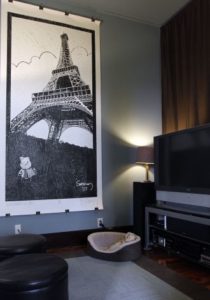
A giant “steamroller print” of the Eiffel Tower hangs on a wall in the media room. The wood block print is by Gary Sweeney.
On the wall of that room is one of the more eye-catching art pieces in the house — a floor-to-ceiling “steamroller print” of the Eiffel Tower with a local artist known as “Bunnyphonic” in the foreground. It is a wood-block print created by artist Gary Sweeney in 2007.
Over the bed in the master bedroom is a set of skateboards minus their wheels painted with views of San Francisco’s “painted ladies” — Victorian homes painted in different hues. The couple honeymooned in that city. The adjacent master bath was a kitchen when the house was a duplex years ago.
The living area is bright and open, with large windows. The living room has a comfortable seating area and a trio of windows facing the Tower of the Americas.

The Tower of the Americas is visible from the front windows. The Bowers say they get a good view of the fireworks on New Year’s Eve.
“We get a great view of the fireworks on New Year’s Eve. It’s a perfect party place,” Krista says.
On one living room wall are two old photographs — one of the home’s builder, Conrad Flaig, and his family, and another of a couple who owned the house in the 1940s. On another wall are two large photos of local scenes by San Antonio photographer Rick Hunter.
In the dining room are two works by local artist Jorge Garza that feature numbers arranged in various ways. There’s also a large, colorful painting by Kori Ashton displayed on top of the storage unit to hide the transom between the dining room and TV room.
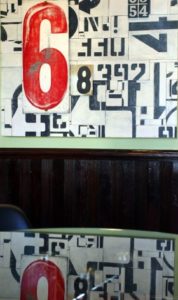
Art work by Jorge Garza is reflected on a glass table in the dining area. Living in the Lavaca neighborhood prompted the Bowers to buy the art they found in the area.
The kitchen has gray granite counters and white cabinets. Carpet tiles on the floor depict an aerial view of skyscrapers.
The kitchen opens to a comfortable screened porch with a wicker seating area and a dining table and chairs. The area had been closed in, but the previous owner knocked out the walls to create a porch. The Bowers screened it in.
“We really enjoy eating out here,” Krista says.
NEW LISTING – 526 Mission St 78210 – $229,000
Contemporary renovation in the King William Historic District. Home is near Eagleland River Walk Expansion & Blue Star Arts Complex. Original floorplan reworked to provide 2 bedrooms and 2 bathrooms. Very open floorplan awash with natural light. Sleek IKEA kitchen & appliances. French doors open onto large deck & yard. Single car garage with space for two car off-street parking. Garage workroom fully plumbed & electrical connections. Completely renovated by CVF Homes. Move-in ready.
Click on the photo for more pictures and information about the house.
San Antonio Rock’n’Roll Marathon gets five more years
The City of San Antonio has just signed a new contract to bring the Rock’n’Roll Marathon back to downtown for the next five years. I’ve had a lot of fun watching it as it comes through Southtown over the past three years. Perhaps I’ll actually train for and run one some year.

